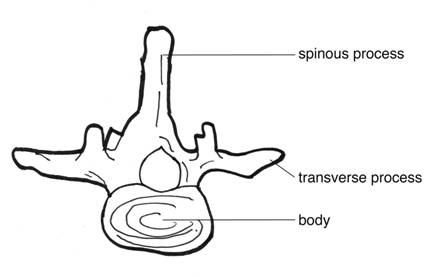The main bones of the skeleton
This section describes the main bones which form the structure of the skeleton.
Skull
The skull is made from 28 bones which are joined together by fibres. 8 of these bones form the cranium (which protects the brain), 14 bones form the face (eye sockets, cheek, nose and jaw) and 6 bones form the middle ear.
Sternum
The sternum is the flat bone in the middle of the chest. It protects the heart and provides a place of attachment for the ribs and the clavicles.
Ribs
Adults have 12 pairs of ribs, which run between the sternum and the thoracic vertebrae, protecting the heart and lungs. 7 pairs of these are known as true ribs and attach to the sternum, 3 pairs attach to the 7th rib and the last 2 pairs, known as floating ribs, do not attach to anything other than a part of the vertebrae.
Vertebral column
The vertebral column is made up of 33 bones. 24 of these are moveable, separated from one another by intervertebral discs, and the other 9 are fused together. Apart from the first two cervical vertebrae (the atlas and axis) which allow us to nod and shake our head all the other vertebrae have a similar basic structure.
The basic structure of a vertebra
(c) Loughborough College
The vertebral column protects the spinal cord, supports the body and head, and provides a place for the ribs and muscles of the back to attach.
The vertebral column is divided into 5 main sections: cervical, thoracic, lumbar, sacral and the coccyx. These can be seen on the diagram below:
The main functions of the vertebral column are to enclose and protect the spinal cord, to support the body and head and to serve as a point of attachment for the ribs and muscles of the back. The function of each section can be seen by clicking on the link below:
Clavicle
The clavicle is attached to the top of the sternum and forms part of the shoulder girdle. It connects the upper arm to the trunk of body and keeps the scapula at the correct distance from the sternum.
Scapula
The scapula connects the humerus (upper arm) to the clavicle (collar bone) and provides a point of attachment for many of the muscles of the upper back and arms.
Humerus
The humerus is the long bone in the upper arm part of the arm.
Radius
The radius is one of the long bones in the lower part of the arm. It is positioned beside the ulna and runs to the thumb side.
Ulna
The ulna is the other long bone in the lower part of the arm. It is positioned beside the radius and runs to the little finger.
Carpals
The carpals are the 8 bones which make up the wrist. They are arranged in two rows of four.
Metacarpals
The metacarpals are the 5 bones between the wrist and the fingers.
Phalanges
The phalanges are the 14 bones of the fingers and thumb. There are 3 bones in each finger and two in the thumb.
Pelvis (illium, pubis and ishium)
The pelvis is also called the pelvic girdle or the hip girdle. It consists of 3 bones, the illium, pubis and ischium, which are fused together. These bones support the weight of the body from the vertebral column and protect and support the lower organs, including the urinary bladder and the reproductive organs.
Femur
The femur is the long bone in the upper part of the leg and forms the knee joint with the tibia.
Tibia
The tibia is one of the long bones in the lower part of the leg. It is the weight-bearing bone of the lower leg and positioned towards the front of the leg.
Fibula
The fibula is the other long bone in the lower part of the leg. It is the non weight-bearing bone of the lower leg and positioned towards the back of the leg.
Patella
The patella bone lies within the patella tendon and floats over the knee. It is one of the three bones, along with the tibia and femur, which form the knee joint.
Tarsals
The tarsals are the 7 bones which make up the ankle.
Metatarsals
The metatarsals are the 5 bones which travel from the ankle to the toes.
Phalanges
The phalanges are the 14 bones of the toes. There are 3 bones in each toe and two in the big toe.

